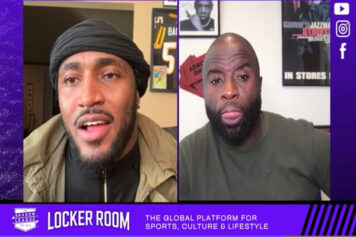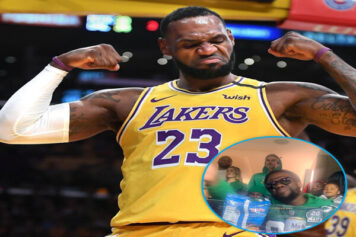At the Miami Heat’s lowest moments in their rocky Eastern Conference Finals clash, ABC, ESPN and TNT’s cameras made a habit of zooming in on team president Pat Riley as he glared intently at the floor, with his hands tucked into his suit pockets and a disapproving look plastered on his face.
A year ago, those images would have perpetuated a misconception that Riley, the coaching legend with an undeniable aura is looming over his shoulder, waiting for a reason to seize the clipboard back. It’s generally never a good idea to follow a legend, but three years into the Big Three era, Spoelstra is bucking that trend by transplanting his own marrow into the Heat’s DNA.
Spo’s taken his fair share of bumps and bruises. Much of it has been an indirect result of Riley’s presence.
Spoelstra was the only NBA coach this past season with a coaching peer as the front office decision-maker. However, Riley’s not just any coach. He’s the Oracle of South Beach. Dwyane Wade is the Mayor of South Beach and LeBron is King James. Spo hasn’t been deemed worthy of a snazzy title yet, but he did finish second in NBA Coach of the Year voting last month.
That’s an unexpected feat for the coach who was perceived to be the Heat’s weakest link. He became the target of vitriol from Heat fans that preferred a seasoned pro with gravitas over Riley’s pet project in the coach’s box. Anytime the Heat struggled during the first two seasons, debates over the Heat’s coveted coaching job became a Game of Thrones-type melee.
Following the Heat’s Game 5 loss to Boston in last season’s Eastern Conference Finals, ESPN’s Chris Broussard lit a match underneath Spoelstra’s smoldering hot seat.
“I feel that there’s a lack of respect for the Heat, because they don’t play up to their potential. They don’t execute, I don’t think they’re well-coached.” Broussard told a Boston radio station. “Maybe it’s not to blame [Erik] Spoelstra; he’s just in over his head. He never should have been put in charge of this situation.”
Spoelstra held down the spot, but he was perceived to be the incompetent protege being propped up by the man behind the curtain. Riley has put more of a mark over the Heat in the last two decades than Chris Andersen’s tattoo artist.
As recently as last season, there was unsubstantiated chatter that he’d oust Spoelstra like he had Stan Van Gundy. After all, it wouldn’t be the first, or second time he’d stepped over the body of a passed out head coach of a team on the verge of a title and carried the baton for the final lap.
Spoelstra’s hard-knocks come-up lacks the storybook pizzazz of Riley’s pampered story, but he’s no featherbrained coaching novice. Riley was groomed as a collegiate player at Kentucky and was on the losing end of Texas Western historic national championship. Then, he spent over a decade of his playing career building his base tan as a member of the Lakers, Phoenix Suns and San Diego Rockets.
Spoelstra's crumpled résumé includes four years hidden away at the University of Portland, and his off-the-grid pro ball in Germany, which probably suits him for a mid-major coaching job in the eyes of a casual observer. The defining moment of his playing career wasn’t any out-of-body scoring experience or a game-winning play. It was being on the court for Portland as Loyola Marymount’s Hank Gathers collapsed and passed away.
Spoelstra’s father was an NBA executive, but this isn’t a story of privilege. Spoelstra grinded for 13 years within the Heat organization, beginning the summer Riley was hired.
“What [Spoelstra] did was prime the pump for 11 years.” Riley told ESPN.com last June. “Sometimes I think being a video coordinator and an advance scout prepares you better to be a head coach than just becoming an assistant coach. You're forced to look at Xs and Os and so many things. He had such a great reservoir of basketball knowledge.”
Spoelstra was depicted as the spring chicken, blindly feeling his way through a high-profile situation. There were stumbles, including the 2011 NBA Finals, their subpar records against squads with .500 or better records, and their 9-8 start to the Big Three era.
In November of that year, amateur body language experts were trying to derive whether James’ bump into Spoelstra during a timeout was inadvertent or a non-verbal disapproval of his methods. The most biting critiques came from Wade, who’d spent seven years with Spoelstra.
“Right now, in my opinion, no one is doing a good job,” said Wade when asked about Spoelstra’s performance through the first 17 games of the Big Three experiment. “We’re 9-and-8. We’re all in this together. The players are not doing a good job. The coach is not doing a good job.”
The most outspoken naysayers took aim at Miami’s stagnant offense, especially in late-game situations during games decided by three-points or less.
Fortunately, winning, and a philosophical change, has cured all.
The overt testament to Spoelstra’s independence has been the success Miami has enjoyed since punting the doctrine that guided Riley’s career for a quarter-century. While fellow generational legend Phil Jackson wifed up the Triangle Offense, Riley’s been playing the field.
However, there was one constant throughout his coaching career. Riley gets down with true centers and won’t leave the house without one. With Magic Johnson still playing near his peak, Riley resigned almost immediately after Kareem Abdul-Jabbar retired. A year later, he was in the Big Apple grinding the offense down to a crawl and building a contender around Patrick Ewing.
A few years later, he swung a deal for Alonzo Mourning in his first week as the coach of the Miami Heat and won a title with Shaquille O’Neal as their centerpiece in 2006. It’s not a fluke, either. According to ESPN’s Brian Windhorst, in the lead up to the 2003 Draft, Riley was infatuated with the prospect of selecting Chris Kaman over Dwyane Wade.
However, over the last two years, Riley has begrudgingly accepted the Heat’s philosophy.
“Our small ball team is who we are now, I just want to have both.” Riley told 640 Sports in Miami last summer.
Much of the transition has been out of necessity, as true centers have gone the way of vinyls and turntables. Spoelstra’s out here mixing with downloadable software. President Riley still holds on to the hope of infusing a traditional center into the lineup this summer, even if it results in Chris Bosh getting voted off the island; Spoelstra’s scheme is based on pace, spacing and small lineups that can thrive in transition.
Miami’s offense is the result of an epiphany that occurred during discussions with Oregon Ducks head coach Chip Kelly during the summer of 2011 NBA. After receiving daily criticism for months about the slow tempo of his offense, Spoelstra took lessons from football’s most frenetic offensive minds and applied them to the Heat.
Following the lockout, the Heat pursued free agent forward Shane Battier and embraced unconventionality by making him their starting power forward. The thought process was simple: Spoelstra sought to open up their plodding offense by spreading the floor with four shooters behind the three-point arc. He borrowed elements from John Calipari’s dribble-drive offense and Rick Adelman’s elbow offense (usually involving a pick and roll guy at the elbow).
Spoelstra’s stepped his outside-in attack up a notch this season by installing a primary offense called The Five, which results in the entire team populating around the perimeter and abandoning the lane like a ghost town. As a consequence, opposing defenses are often vulnerable to penetration and kickouts via Wade and LeBron.
“What everybody wants to do is put their best defender on LeBron and try to help as little as possible,” one scout told Sports Illustrated. “Because if you have to help, they have so many shooters. Even if you rotate well once, twice or three times, the ball is going to find the shooter.”
The result was an offense that ranked first league-wide in points per possession and aided the Heat during their 27-game winning streak, as they sliced through the league’s defenses like a chainsaw. More importantly, the Heat remained one of the best defensive small ball teams in league history.
Spoelstra will always get graded on a curve for guiding the Heat to three consecutive NBA Finals’, but either way, Riley and Spoelstra know their roles. Spoelstra has arrived as coaching nobility and he’s not exiting the spotlight anytime soon. However, it's all about perception.
Finals week isn’t just a litmus test of Miami’s Big Three against San Antonio’s. Another coaching legend is standing in Spoelstra’s path in the Finals. The age difference between the 42-year-old Spoelstra and the 64-year-old Popovich is the greatest age disparity between NBA coaches in Finals history.
Pop is Spoelstra’s latest Rorschach Test. Like Riley, Pop’s one of the few strategists who can bridge a vast talent gap with superior coaching acumen. The last thing Spoelstra needs after barely scraping by Frank Vogel’s Pacers is to enter the offseason as a loser of two in the last three NBA Finals’ while whispers circulate around the availability of virtuosos like Doc Rivers, Lionel Hollins, and Phil Jackson.
Beating Scotty Brooks’ Thunder brought him some overdue credit around the league, but a victory over Pop would be a watershed moment in his career.
Spoelstra needs to add some weight to his C.V. and secure his legacy. Throwing a second chip on his résumé against a coach of Pop’s ilk should do the trick.



